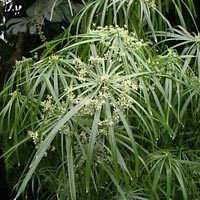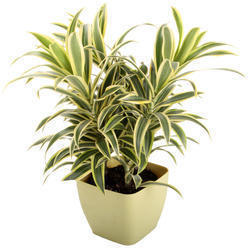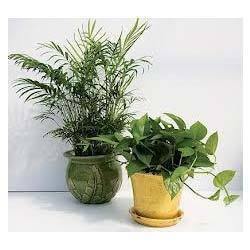Carnivorous Live Pitcher Plant Nepenthes
Price 25 INR/ Kilograms
MOQ : 5 Kilograms
Carnivorous Live Pitcher Plant Nepenthes Specification
- Type
- Plant
- Variety
- Nepenthes
- Part
- Leaves
- Color
- Green
- Shelf Life
- 1-2 Years
Carnivorous Live Pitcher Plant Nepenthes Trade Information
- Minimum Order Quantity
- 5 Kilograms
- Payment Terms
- Cash in Advance (CID), Cash Advance (CA)
- Supply Ability
- 10000 Kilograms Per Week
- Delivery Time
- 2-7 Days
- Main Export Market(s)
- Australia, North America, South America, Eastern Europe, Middle East, Central America, Western Europe, Asia, Africa
- Main Domestic Market
- All India
About Carnivorous Live Pitcher Plant Nepenthes
Nepenthes, popularly known as tropical pitcher plants or monkey cups, is a genus of carnivorous plants in the monotypic family Nepenthaceae. The genus comprises roughly 140 species, and numerous natural and many cultivated hybrids. They are mostly liana-forming plants of the Old World tropics, ranging from South China, Indonesia, Malaysia and the Philippines; westward to Madagascar (two species) and the Seychelles (one); southward to Australia (three) and New Caledonia (one); and northward to India (one) and Sri Lanka (one). The greatest diversity occurs on Borneo and Sumatra, with many endemic species. Many are plants of hot, humid, lowland areas, but the majority are tropical montane plants, receiving warm days but cool to cold, humid nights year round. A few are considered tropical alpine, with cool days and nights near freezing. The name "monkey cups" refers to the fact that monkeys have been observed drinking rainwater from these plants. The Indian Nursery also accepts small orders on Nepenthes.
Features of Nepenthes Pitcher Plants
Nepenthes plants, distinguished by their vibrant green leaves and specialized pitcher-shaped traps, thrive in humid climates. Their carnivorous nature allows them to attract and digest insects, naturally nourishing the plant. This variety is supplied fresh, ensuring the distinctive features and longevity of each specimen remain intact for up to 2 years.
Export Quality from India
Indian exporters and suppliers maintain strict standards when sourcing and distributing Nepenthes pitcher plants. Each specimen is carefully handled to preserve its health during shipment, making these plants a reliable choice for traders and wholesalers worldwide seeking quality and vitality in carnivorous plants.
FAQs of Carnivorous Live Pitcher Plant Nepenthes:
Q: How do Nepenthes pitcher plants catch and digest insects?
A: Nepenthes pitcher plants use their specialized leaves to form pitcher-shaped traps. These traps contain nectar that attracts insects, which then fall inside and are digested by the plants enzymes for nutrients.Q: What is the process for importing Nepenthes plants from India?
A: Exporters in India ensure that Nepenthes plants are packed securely and comply with international phytosanitary standards. Interested buyers can contact reputable manufacturers, suppliers, traders, or wholesalers for bulk or individual shipments.Q: When is the best time to plant Nepenthes pitcher plants?
A: Nepenthes pitcher plants thrive when planted during the warmer months, preferably in spring or early summer, which gives them plenty of time to establish before cooler weather arrives.Q: Where should Nepenthes pitcher plants be placed for optimal growth?
A: These plants perform best in locations with bright, indirect light and high humidity. They can be positioned indoors near windows or outdoors in shaded areas that protect them from harsh sunlight.Q: What are the benefits of owning a live Nepenthes pitcher plant?
A: Besides their captivating appearance, Nepenthes pitcher plants act as natural pest controllers by trapping and digesting insects, enhancing the health of their surroundings without chemicals.Q: How long will the Nepenthes plant remain healthy after purchase?
A: With proper care, the shelf life of a Nepenthes pitcher plant ranges between 1 to 2 years, during which it will continue to produce new pitchers and grow if its environmental needs are met.
Tell us about your requirement

Price:
Quantity
Select Unit
- 50
- 100
- 200
- 250
- 500
- 1000+
Additional detail
Mobile number
Email
More Products in Indoor and Outdoor Plants Category
Live Indoor Plant
Price 21 INR / Kilograms
Minimum Order Quantity : 5 Kilograms
Type : Plant
Color : Green
Part : Leaves
Shelf Life : 13 Years
Umbrella Grass
Price 23 INR / Kilograms
Minimum Order Quantity : 5 Kilograms
Type : Plant
Color : Green
Part : Leaves
Shelf Life : 12 Years
Decorative Plant
Price 20 INR / Kilograms
Minimum Order Quantity : 5 Kilograms
Type : Plant
Color : Green
Part : Leaves
Shelf Life : 14 Years
Indoor Plants
Price 20 INR / Kilograms
Minimum Order Quantity : 5 Kilograms
Type : Plant
Color : Green
Part : Leaves
Shelf Life : 15 Years




 Send Inquiry
Send Inquiry





